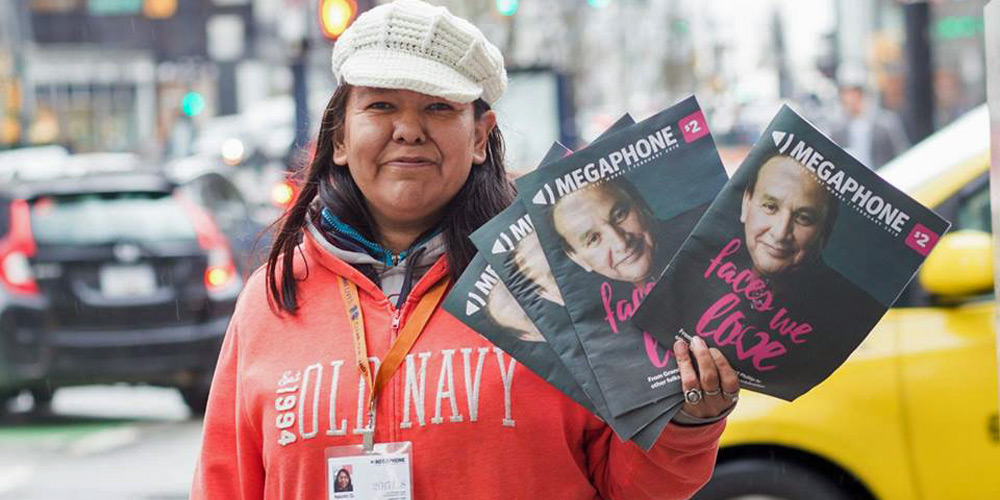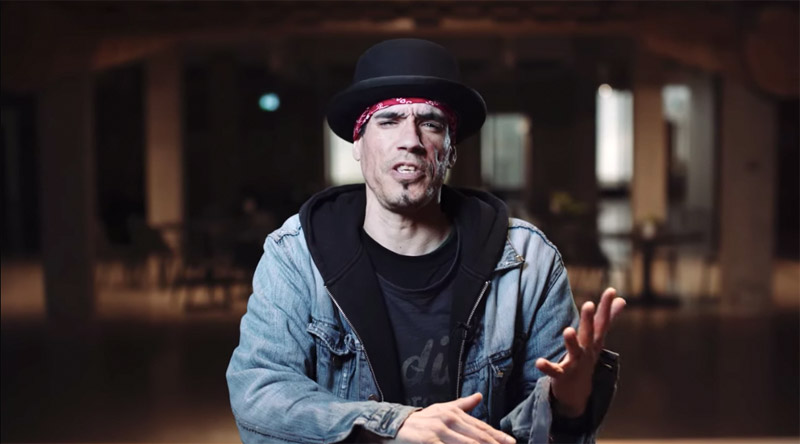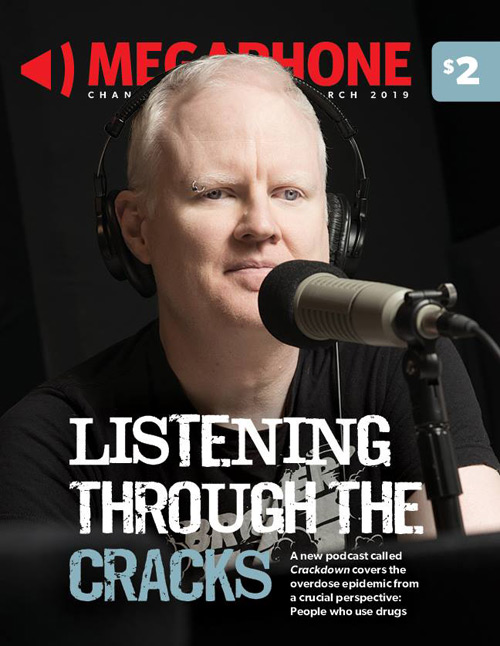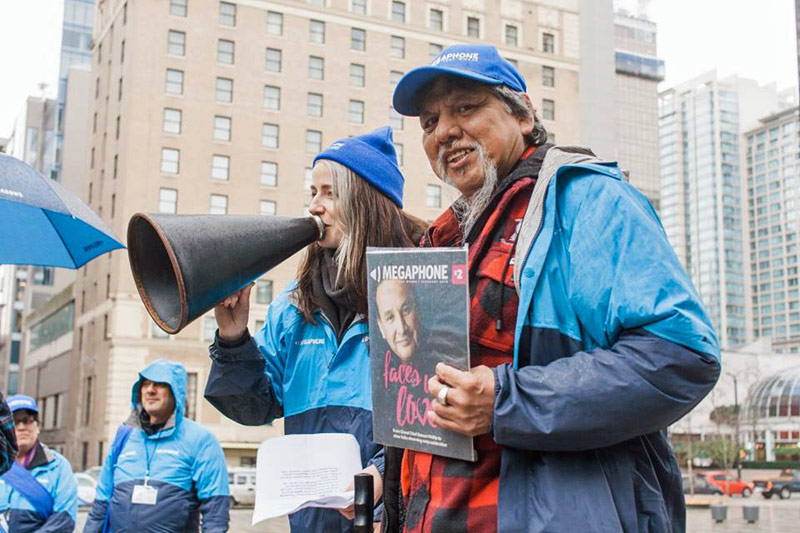
Nicolas Leech-Crier has always been a storyteller. He grew up performing in plays and later co-wrote his own series of acclaimed vignettes. Today, he’s a coordinator for Megaphone magazine’s speakers bureau, highlighting stories from Vancouver’s Downtown Eastside (DTES), where he lives.
The DTES is a low-income neighbourhood at the heart of Vancouver, located on unceded Musqueam, Tsleil-Watuth, and Squamish First Nations territories.
The neighbourhood has been sharply affected by the overdose crisis, and is a centre of North American drug-use activism. That’s made it one of the most researched neighbourhoods in the world — and one that attracts plenty of media attention.
But often, the press has not done the DTES justice. Decades of bad coverage have painted the neighbourhood and its residents with stigmatizing, demeaning language that residents say has often hurt the community more than it’s helped.
Leech-Crier is one of many residents working to change the narrative around his home by coaching speakers and writing at Megaphone. Their mission? Making sure the stories that matter are actually told.
“That’s what I tell my speakers — you’re there to share your truth and do so with respect and maturity and in a calm manner,” says Leech-Crier. “And be willing to forgive and work together to move forward on this in the right way, so our children don’t have to grow up in a world where they worry about being misrepresented — so we can just be honest about it.”

There have been hundreds of studies published about the DTES. But if you ask an average Vancouverite, all they know about it is what they read in the headlines.
For decades, the neighbourhood has been called “Canada’s poorest postal code” — a label that hasn’t technically been accurate for years, but has continued to colour its reputation.
In 1981, The Globe and Mail wrote that the area’s “perpetual drunks” were “occasionally violent and almost always disgusting.” In 1994, they called it “a world of sagging flophouses and soup kitchens.” In 1996, they published a horrifying anecdote about a drug user overdosing, quoting a cop who called the victim’s spasms “the cocaine dance.”
Even last year, the paper ran a column with lines like, “A man with lank black hair is slumped against a wall, bent over double like a limp marionette, his dangling arm twitching at his side.” It was, as the column claimed in its lede, “just another day on Vancouver’s Downtown Eastside.”
Residents, understandably, are fed up with it.
“I think if you ask the average person who lives here, the attitude towards reporters is generally cynical,” says Fiona York, the coordinator of the Carnegie Community Action Project, a non-profit that advocates for over 10,000 DTES residents.
She says there have been times that press coverage has helped spark change by highlighting activism in the neighbourhood. But most of the time, it’s been what she and many residents call “parachuting in.”
“I think of it as extractive journalism,” says Jessica Hannon. Hannon is the executive director of Megaphone, a community-based magazine that features work from journalists and residents.
“It’s kind of parachuting into the community, hustling a story, and smuggling it out to the front page of the paper,” she says.
Often, that story is “poverty porn” — dramatic, stigmatizing descriptions that ignore the good things happening in the community. That creates a harmful stereotype around residents that York says has actually created barriers for some of them in finding work or accessing medical care outside the community.
“We read about the DTES as a world unto itself,” says David Hugill, a professor of urban geography at Ottawa’s Carleton University. “The problem with this framing is that it is historically, politically, and economically bogus.”
Hugill is the author of Missing Women, Missing News: Covering Crisis in Vancouver’s Downtown Eastside. The book examines the surge of coverage of the DTES during the trial of Robert Pickton — a serial killer who targeted sex workers and other vulnerable women, many of them Indigenous.
Hugill notes there was little coverage when the women actually went missing. But once Pickton was caught, media from across the continent came to the DTES, and then promptly left once it was finished.
That means the bigger story — of why the DTES has the challenges it does and why Pickton’s victims were ignored for so long — didn’t get properly told.
The DTES “isn’t disconnected from other parts of Vancouver,” Hugill writes in a message to Canadaland. “It exists in the form that it does precisely because of its relationship to other parts of the city. It is not an organic creation but the product of a very clear set of struggles, purges, and evictions.”

It doesn’t have to be this way. And in many ways, it isn’t.
In recent years, local residents, activists, and journalists have led a change in how reporting in the community happens, offering a set of ethical guidelines for how to conduct research and reporting in a positive way.
Last year, Leech-Crier and 13 other residents met at roundtables organized by Simon Fraser University and Hives for Humanity, a local beekeeping non-profit that also works to foster good ethical practices for researchers in the neighbourhood.
They discussed the flood of research conducted on the community and how the DTES could actually benefit from it.
The result was Research 101: A Manifesto for Ethical Research in the Downtown Eastside, which urges researchers to ask themselves some key questions before they come to the neighbourhood — something local journalists agree is vital.
Canadaland spoke to some of those writers and other activists, doing our best to follow the rules they set out.
A syringe in a gutter. A man huddled against a building. The doors of Insite, North America’s first safe-injection site.
Images of outdoor drug use are common in coverage of the DTES. But journalists caution against perpetuating the myth that all residents are drug users — and exploiting people who are forced to use outside by taking their photo.
“It’s actually a bit lazy when journalists are like, ‘Well, we want to shoot drug use, so let’s go to where people are so poorly housed that they’re out on the street,’” says Garth Mullins, a longtime community organizer, journalist, and drug-user activist.
Mullins is the host of Crackdown, a monthly podcast where drug-user activists tell the story of the overdose crisis from its frontlines. He’s sharply critical of media coverage that dehumanizes people who use drugs — especially when it does so by comparing them to animals or zombies.
“Not only is it stigmatizing to the person who has to use outside, but it’s also really bad journalism….It tells a stereotype,” he says. “Why did you use a picture of a syringe in a gutter if your story has nothing to do with that?”
Travis Lupick is a writer for The Georgia Straight and the author of Fighting for Space: How a Group of Drug Users Transformed One City’s Struggle with Addiction.
He says part of the reason for negative coverage is that newsrooms have unrealistic expectations of their writers, causing them to revert to stereotypes.
“It’s one reason I’m not so hard on journalists for making certain mistakes, because their outlets have put more on their plate than anyone can manage with real quality,” he says.
Building relationships with marginalized sources requires time and trust.
“There’s too often an assumption that people’s time is free, which couldn’t be further from the truth,” says Scott Neufeld, a PhD candidate at Simon Fraser University who helped facilitate the manifesto workshops.
“People’s time, especially if they’ve got really low incomes … They don’t have an hour of unpaid work to sit and chat with some reporter.”
Lupick says most Vancouver-based journalists do a good job covering the community. But when an outlet comes from other parts of Canada or the United States, they often have a strict deadline and little historical context — which causes them to get the story wrong.
“They’ll see Insite on East Hastings Street and see the intense poverty and the intense drug use and the garbage on the ground, and say, ‘Look what Insite has done,’” he says. “But that’s not what Insite has done. That’s why Insite is needed.”
Megaphone’s Hannon has sympathy for journalists on a tight timeline. But she doesn’t think that excuses the impact of bad reporting.
“I don’t think it’s good enough to accept those pressures as a justification for hurting people who are in vulnerable positions,” she says.

Perhaps because of this, residents are chronically underrepresented in stories about their own communities.
“One of the most common mistakes I’ve seen with reporters in marginalized communities is when reporters don’t include voices of the people they’re reporting on,” says Lupick.
A 2013 study in The Canadian Geographer found that in a sampling of articles published by the Vancouver Sun and Province from 1997-2008, politicians, police, and journalists were all more likely to be cited as “defining” sources in stories about the DTES than actual residents.
Rather than just pushing for a story, the writers of the manifesto recommend actually working with community members to gain familiarity with the neighbourhood — both as a way of gaining access and to avoid falling into harmful, inaccurate stereotypes.
Leech-Crier has spoken to reporters several times. But on one occasion, he felt them getting frustrated.
The reason? He believed they were looking for a soundbite of a “downtrodden Downtown Eastsider” and were mad his answers were “too good.”
“That’s an inhumane way to treat people who are willing to give their time to share knowledge or experience, especially in this climate with all the loss and grief,” he says.
Many residents have similar stories, which means they’re often skeptical about sharing their opinions with journalists visiting the neighbourhood for stories, as noted last year in The Tyee.
But Leech-Crier has also worked directly with media. One video team paid him to help guide them through the neighbourhood’s alleys while reporting on the opioid crisis, which Leech-Crier says allowed them to establish trust with overdose workers and avoid running into trouble.
When residents do agree to an interview, Lupick says journalists should be conscious about their ethics and ask themselves some tough questions.
“A good one is, ‘Would I do this if I were reporting on a privileged community?’” he says. “Would you stand in front of someone’s home in a rich part of town documenting what happens in their front yard?”
Mullins, who frequently interviews people who use drugs, stresses making sure sources are comfortable with the quotes that will be attributed to them — especially if they share personal details, like drug use, that could stigmatize them.
“If someone says, ‘Holy crap, I just realized my grandmother is going to listen to this. You can’t do this,’ we say, ‘Okay, should we pull the clip? Should we change your name?’” says Mullins.
“You try to give people agency, but in practice it’s not a veto. If there’s a clip where someone is really raw, I don’t feel good unless I can play that clip to the person and explain what’s going on and how we’re going to use it.”
Sharing copies of quotes before a story is published might seem at odds with normal journalistic practice. But as Hannon points out, the normal “rules” of journalism are based on holding the powerful to account. When the reporter is the one with the power, the rules are different.
“I don’t think that’s sacrificing objectivity,” she says. “I think that’s just being human and being thoughtful and approaching things from a different perspective.”
Leech-Crier says when he shares his story and expertise, he should be respected in the reporting process — which means knowing how he’ll be portrayed.
“I was willing to give myself and my time and the most intimate details of my life,” he says. “But you’re not going to share it with me before you share it with everybody?”
The biggest ethical question is the simplest: Why are you here, anyway?
“Why are you doing this research? Why do you have the research questions that you have?” asks the manifesto. “Could they be framed a different way? Are you asking the wrong questions? Who is your research for? Who doesn’t already know the answer to your research questions and why do they need to know?”
For a reporter on deadline, it might seem like a lot. But it’s worth asking why media covers the DTES. Is it to highlight stories of strength and resilience amongst an incredibly complicated socio-economic environment? Is it to challenge power structures that have led to poverty? Or are you just looking for a sad photo?
“What is it specifically that you’re doing there that isn’t happening somewhere else, and are you there because of laziness?” says Mullins.
“If you’re going there because you can find drug users there, because people don’t have privacy, then that’s a shitty reason to be going there.”
Once an article is done, the journalist shouldn’t just disappear.
One of the reasons community-based publications and writers are the community’s best storytellers are because they’re accountable to their sources. Leech-Crier calls this coming “full circle” — bringing the story back to where it came from.
Crackdown is overseen by an editorial team that includes members of the Vancouver Area Network of Drug Users (VANDU), which keeps Mullins accountable to the podcast’s mission.
“It helps us figure out a sort of a manifesto of power for how we’re gonna conduct our journalism,” he says.
Unlike many reporters, Lupick actually lives in the DTES.
“I know that the people who I quote in my stories are going to be people I’m bumping into the next day or week,” says Lupick. “And if I misquote them or get something wrong, I’m going to hear about it, sometimes quite forcefully.”
One of Megaphone’s best-known projects is Hope in Shadows, a calendar of photos of the DTES taken by residents.
The photos show a side of the neighbourhood you won’t catch on the news — residents winking at the camera, smiling on a park bench, and being themselves.
“If the only image that we ever see of the Downtown Eastside or of people who are experiencing poverty is that struggle, or that really gritty and hard-to-stomach part of their lives, we really reduce those individuals or those communities to a one-note version of their lives,” says Hannon. “I think that’s really hard for people to connect with. We kind of erase people’s humanity by doing that.”
Leech-Crier says he can’t speak for the whole community — but he’s optimistic about the changing ways people see his home.
“There’s evolving processes here, and they’re just going to keep evolving exponentially,” he says.
“These moments of enlightenment dawn on us, and we realize, ‘That’s so simple. We could have been doing it so simply all along.’”
The 2019 edition of Megaphone’s annual literary anthology, Voices of the Street, launches tonight, May 27th, at SFU Woodward’s in Vancouver.
Top image, of Megaphone vendor Naomi, from Megaphone‘s Facebook page.
Correction (5/28/19 at 1:10 a.m. EDT): This piece originally described Nicolas Leech-Crier as a coordinator for Megaphone‘s Voices of the Street anthology. He is, in fact, a coordinator for Megaphone‘s Speakers Bureau.